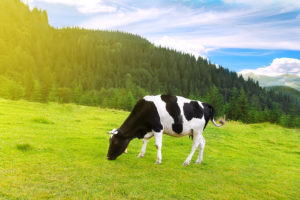Why Grass-fed Beef Is Better
Sarah Heckler, MS, RD, LDN, CISSN
Grass-fed beef has gotten more popular recently for health and environmental reasons. To truly understand the health benefits, it’s important to look at the digestive system of a cow.
Cows Have a Unique Digestive System
Cows have a ruminant digestive system that allows them to forage on and digest wild grasses. The cows’ rumen is like a large holding tank. A mature cow can store up to 55 gallons of grass.
Cows do not chew their food thoroughly the first time they eat it. In fact, they have the ability to un-swallow their food, re-chew and swallow again, allowing them more time to process the grass. This process is called rumination. It is made possible by the digestive anatomy of the cow.
Most mammals, including dogs and humans, do not have the ability to break down plant material. But a cow’s rumen is different. The rumen contains tiny organisms that help break down the plant material, that would not normally be digested. The rumen acts not only as a holding tank but also a food processor allowing the cow to consume and digest wild grass.
Grain-fed vs. Grass-fed Cows
What really is the big difference between grass-fed and grain-fed cows?
Grass-fed cows are allowed to forage on wild grasses, meaning they are allowed to eat as much or as little as they want. The cow has control over how much it consumes. The grass-fed cow is allowed to eat and grow at it’s normal rate. Since the cow is only eating grass it tends to be leaner, which results is less fat in the meat. Since fat is flavor, high fat beef is generally better accepted by Americans.
Grain-fed cows, on the other hand, are refined to an enclosed area. They are fed a combination of soy and corn as well as antibiotics and hormones to produce bigger cattle in a shorter amount of time.
Bigger cattle and less time means more meat to sell and more money to be made. The demand for beef is high in our country, with the United States consuming 52.2 billion pounds in 2012. Farmers have to keep up with this demand so the industry discovered ways to fatten up cattle in shorter amounts of time, thus the use of grain diets.
Health Benefits of Grass-Fed Meat
Research has shown that grass-fed beef has an improved fatty acid and antioxidant content compared to grain-fed beef. Grass diets have been shown to enhance omega-3 fatty acids as well as conjugated linoleic acid (CLA), on a gram to gram fat basis.
Plus, grass diets have led to a higher proportion of steric fatty acid, a cholesterol neutral fatty acid, as compared to the cholesterol elevating saturated fatty acids in grain fed beef.
Lastly, the fat from grass-fed beef may appear more yellow in color due to the higher carotenoid content, which is a precursor to vitamin A. In summary, grass-fed beef has:
- less overall fat
- more omega-3 fatty acids
- higher proportion of steric acid
- higher carotenoid content
More Than Just Health Benefits
- Grass-fed beef is better for the environment because less energy goes into the production of growing grass as compared to grain.
- Grass-feeding is more humane, cattle are allowed to forage, meaning they can eat as much or as little as they would like. Plus, they are eating what their unique digestive systems were designed for.
Before you reach for your next hamburger or steak think about where your food comes from and how it is produced. Become an informed consumer and protect your health!
Got more questions about grass-fed beef or how to choose the best foods for you? We can help! Learn more about our nutrition services here.




